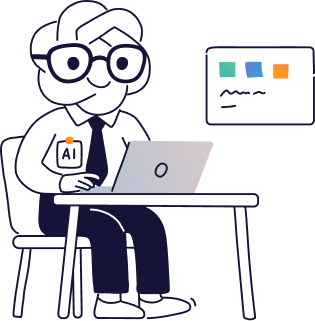If you’re a product manager or work closely within this role, let me ask you honestly: have you ever wondered whether AI could replace your job?
17% of product managers (PdMs) genuinely believe that an intelligent machine might take their place. While the number isn’t alarming, it signals a creeping anxiety in the industry.
Let me reassure you: there’s no need to fear AI itself. That said, PdMs should be aware that many are still figuring out how to use it effectively or build it into their skill set.
Despite all the guides and best practices out there, product managers still hesitate, make assumptions, avoid learning, or rush to use AI without a strategy — and that’s a mistake.
I’ve been working with AI since 2017 (yes, the same year transformer architecture arrived, that’s the T from GPT), not only integrating it into products but also making it a reliable second brain. So if you’re a thoughtful product manager and you’re finally ready to make AI your true assistant, keep reading.

Check whether you are ready for AI
Before jumping into practical tips, let’s start with something less traditional — not tools, but you as a product management specialist. Before integrating AI, ensure that you are:
1. T-shaped professional
A product manager needs broad knowledge spanning psychology, marketing, design, and software development processes. This wide base provides essential context and understanding. At the same time, you must explore specific technologies and grasp the unique aspects of your industry. Product management is a complex field as it requires expertise from many areas. So, balancing breadth with depth is essential.
2. Connected to reality
One frequent challenge is losing connection with actual users and the broader market. It’s easy to get absorbed in technical details or overly rely on AI outputs, neglecting direct communication with your customers. Maintaining this connection ensures that AI supports meaningful, user-centred decisions rather than becoming a distraction.
3. Able to make hard calls
There are rarely 100% “right” answers, as most decisions depend on various factors. Data is crucial, but ultimately, it’s just one of many inputs. Making decisions under uncertainty is a core skill. Sometimes intuition guides you, other times you rely on structured approaches, such as decision trees.
4. A truly data-driven specialist
Being data-driven means more than just juggling statistics. It begins with pinpointing exactly what information you need to address your key challenges. Next level — pump up your data gathering skills to ensure you do it reliably and efficiently. And, of course, master your ways of examining your data and fishing out valuable insights.
Beware of the analysis paralysis trap, though. There’s a delicate balance between having “just enough” and “too much” data. So, setting firm deadlines for decisions can help avoid getting stuck in endless evaluation and keep projects progressing smoothly.
With these four foundational skills, you’ll be ready to integrate AI into your daily workflow confidently. Here’s why mastering them matters:
- AI won’t replace your judgment. It can offer insights and recommendations, but the final decisions are always yours to make. Understanding this prevents overdependence on technology.
- AI’s analysis isn’t infallible. Its outputs require your careful review and critical thinking before you trust or act on them. Without this, mistakes can slip through unnoticed.
- Effective communication with AI is essential. Knowing how to ask precise questions and interpret responses ensures you maximise the value AI can provide.
One increasingly popular example is the AI meeting copilot – a tool that not only transcribes conversations but also highlights action points, drafts follow-ups, and helps ensure no key insight gets lost in a sea of discussion.
How to set up AI as an assistant
So now, let’s start with a guide on how to onboard a junior AI assistant effectively:
1. Focus on one clear goal at a time
Once you know which tasks can benefit from AI, setting a clear goal for your AI assistant is crucial. Even though multitasking is common, when working with AI, it’s best to focus on one clear objective at a time. Having a precise goal helps you craft well-defined questions and prompts, guiding the AI to provide relevant and actionable answers. Without a focused purpose, the AI’s responses can become scattered or vague, making them less helpful.
For best results, organize your work in ChatGPT or Claude into separate projects — ideally, one per task type or closely related types. Each project should include its own clear instructions. Then, use a separate chat thread for each specific task. Keeping tasks granular helps maintain clarity, as AI models have limited context windows and struggle with context switching.
2. Give your AI assistant a clear role
Another step is teaching your AI assistant to adopt a specific role or persona. Unlike a simple search engine, generative AI performs best when it understands the context and perspective it should take.
For example, instead of asking for three generic scientific facts, you might frame your prompt like this: “Imagine you are a renowned scientist with a PhD and numerous publications, speaking to a teenager who is indifferent to science. What three engaging facts would you share to spark their interest?” This role-playing approach helps the AI tailor its responses with greater depth and relevance.
Building on this idea, many organizations are now exploring agentic AI for enterprises, enabling AI assistants to operate autonomously across complex workflows, make context-aware decisions, and scale across teams, thereby enhancing overall efficiency and strategic impact.
3. Learn the basics of how AI works
You don’t have to be an AI engineer, but having a foundational knowledge of how AI models work is vital. Understanding how AI processes data, learns patterns, and generates results helps you interact with it more effectively and critically evaluate its outputs.
Without this insight, it’s easy to treat AI as a mysterious “black box,” which leads to blind trust or misinterpretation. Knowing the basics enables you to recognise when AI might be wrong or uncertain and when a human review is necessary to ensure quality and accuracy. As a recommendation can be Andrew NG’s courses.
4. Don’t overlook the power of simple machine learning methods
Traditional machine learning methods are often underestimated. Many challenges can be effectively addressed with straightforward approaches rather than immediately reaching for advanced tools like transformers or generative neural networks. Basic models such as regression and decision trees still perform remarkably well, especially for routine operational tasks.
Many teams rush to tackle complex problems like supporting copywriters, streamlining design workflows, or accelerating coding. Yet, the essential groundwork often remains neglected: tasks in finance, operations, and administration frequently involve repetitive manual work that simple machine learning solutions can automate with ease.
The greatest value of AI comes from eliminating these tedious tasks, freeing people to focus on more creative and impactful work (and not flashy gimmicks like generating silly or cute images on demand).
It’s okay to be unsure — but it’s not okay to stop trying
The most valuable step you can take as a product manager is to overcome fear and start experimenting. You won’t have all the answers, and that’s okay — knowledge gaps, time constraints, and imperfect outcomes are part of growth. Progress comes from trying, learning, and iterating, not waiting for perfect conditions.
Remember, technology should enhance your expertise, not replace your judgment. Use automation to free yourself from repetitive tasks, allowing more focus on strategic decisions and creative problem-solving. By blending your experience with thoughtful automation, you turn uncertainty into opportunity and lead meaningful solutions, not hyped.
